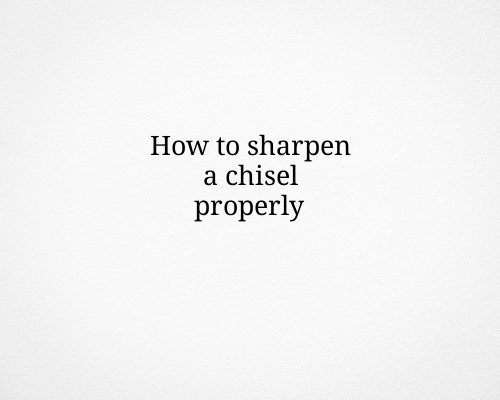Sharpening a chisel properly ensures precise cuts and extends the tool’s lifespan. Follow these steps to get a razor-sharp edge on your chisel:
Tools and Materials Needed:
- Sharpening stones (coarse, medium, and fine grit; oil or water stones)
- Honing guide (optional but recommended)
- Lubricant (water or honing oil, depending on the stone type)
- Strop with polishing compound (for final honing)
- Flat surface (like glass or granite) (for stone stability)
- Rag or paper towel
Step 1: Flatten the Back of the Chisel
Before sharpening the bevel, ensure the back of the chisel is perfectly flat.
- Start with a coarse sharpening stone (around 220 grit).
- Place the chisel flat on the stone with the back facing down.
- Move it back and forth in a circular or figure-eight motion.
- Progress to medium (1000 grit) and fine stones (4000–8000 grit) until the back is polished and smooth.
✔ Tip: Only flatten the first inch or two of the back; the rest doesn’t matter.
Step 2: Set the Correct Bevel Angle
The ideal bevel angle is 25–30 degrees:
- 25° for softwood cutting (razor-sharp but less durable)
- 30° for heavy-duty tasks (more durable but slightly less sharp)
To maintain this angle:
- Use a honing guide for consistency.
- If sharpening freehand, tilt the chisel slightly until the bevel sits flat against the stone.
Step 3: Sharpen the Bevel
- Start with a coarse stone (220–400 grit) and apply lubricant.
- Move the chisel back and forth or in a figure-eight pattern while maintaining the bevel angle.
- Check for a burr (tiny ridge of metal) on the back—this means the edge is sharpening correctly.
- Progress to medium (1000 grit) and fine (4000–8000 grit) stones for a refined edge.
✔ Tip: Use light, even pressure and cover the entire bevel evenly.
Step 4: Hone the Edge
For the sharpest edge:
- Place the chisel’s bevel flat on a leather strop with polishing compound.
- Pull it backward 10–15 times (never push forward).
- Flip the chisel and lightly strop the back to remove the burr.
✔ Tip: Stropping polishes the edge and extends sharpness without frequent sharpening.
Step 5: Test the Edge
A properly sharpened chisel should:
✅ Slice through paper effortlessly.
✅ Shave thin wood shavings with little pressure.
✅ Reflect light smoothly along the edge.
If dull, repeat the honing process.
Maintenance Tips:
- Hone regularly to maintain sharpness longer.
- Store chisels properly (in a rack or case) to prevent edge damage.
- Avoid hitting nails or hard surfaces that can dull the edge.
- Use proper technique while chiseling to minimize wear.
By following these steps, your chisel will stay razor-sharp and ready for precise woodworking!
